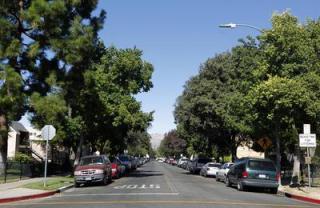Contra Costa Times
Gauge of neighborhood wealth? Look to the trees
Posted: 09/10/2012 7:36 AM

When the chief of the U.S. Forest Service landed in the Bay Area last month, he skipped the redwood forests to visit a treeless West Oakland sidewalk across from a used car parts shop.
The reason? To plant trees where they were needed most.
"If you have a tree-lined street, people are more likely to shop there," said Forest Service Chief Tom Tidwell. "If you have a tree-lined street, property values go up. ... The more trees we have, the cleaner the air."
It might be obvious to anyone who has ever climbed a backyard maple, cooled off beneath an oak, plucked a fruit or admired an evergreen landscape, but a growing body of scholarship is confirming that trees are deeply tied to our economic well-being, health, safety and happiness.
To demonstrate, some tree enthusiasts are taking a high-altitude view: peering at Earth from afar can distinguish a wealthy neighborhood from a poor one by its leafy canopy.
"Not only do rich people have more trees than poor people, they have a lot more trees than poor people," said environmental writer Tim De Chant, whose website went viral this summer after he blogged a series of satellite photographs titled "Income equality, as seen from space."
Starting with tree-starved West Oakland and juxtaposing it with affluent, leafy Piedmont, he invited people around the world to document their neighborhood canopies.
"The reaction has been overwhelming," said the former East Bay resident, now a researcher living in Massachusetts. "They recognize this same sort of thing in their own neighborhoods or cities."
Redwood City, despite its name, looks a lot less verdant from space than neighboring Atherton, one of America's wealthiest towns.
Palo Alto and East Palo Alto take their names from a tall, millenium-old redwood that now looms over the Caltrain tracks, but it's clear from above that better-off Palo Alto is greener than its eastern neighbor.
De Chant's Per Square Mile blog documents similar green-gray metropolitan divides matching poverty and income disparities from Mexico City to Hong Kong.
So if trees signal wealth, some ask, why don't people in hardscrabble neighborhoods plant more of them?
"It comes down to money," De Chant said. "Urban forestry is often left to cities and neighborhoods and if cities and neighborhoods don't have resources to do it, they focus on other things, such as sewers and roads."
Cost is a factor but so are space, geography, soil, stormwater management, property ownership and community involvement, said Tidwell, whose agency awards about $32 million a year to urban forestry programs around the country.
Without long-term commitment, Tidwell said, it can be hard to maintain a tree rooted in the compacted soil of a street median or sidewalk box.
"Our urban trees ... have to be able to survive in a tougher environment," he said.
For decades, Bay Area organizations have been trying to fill the green gap. Tidwell came to Oakland last month to award $181,000 to 14-year-old Urban Releaf, which has planted more than 12,000 trees in Oakland and Richmond and focuses on getting youths intimately invested in the projects.
Others are looking to Earth-orbiting satellites.
In San Jose, a team of UC Davis geoscientists has spent months computing and taking old-fashioned field visits to map every block of the sprawling city's canopy.
"Knowing what you have is the first step of knowing where you want to go," said Julia Bartens, whose team analyzes satellite images and measures the economic value and energy savings of San Jose's vegetation.
Bartens said the data will help the city and its nearly 1 million residents pinpoint the public and private land that could, and probably should, have more trees.
Among those awaiting the information is Rhonda Berry, who runs Our City Forest, a group that has helped plant 65,000 trees in the city since 1994.
Almost everyone wants neighborhood trees, but the lowest-income residents are usually renters who don't own the land on which trees can be planted and sustained, Berry said.
She has shifted part of her group's mission from public plantings to distributing private trees.
"We work really hard to talk property owners into getting trees," said Berry, but to many landlords and public agencies, "more trees means more maintenance, more cost."
Years of academic research showing how trees scrub air pollution, reduce mental stress, lower crime rates and raise real estate values demonstrate that cities neglect them at their peril, Berry and other tree enthusiasts say.
"Trees are still considered a decoration, something you add to a project after the fact," Berry said. They are "part of our infrastructure and there should be a design to include it, just as there's a design to include sidewalks."